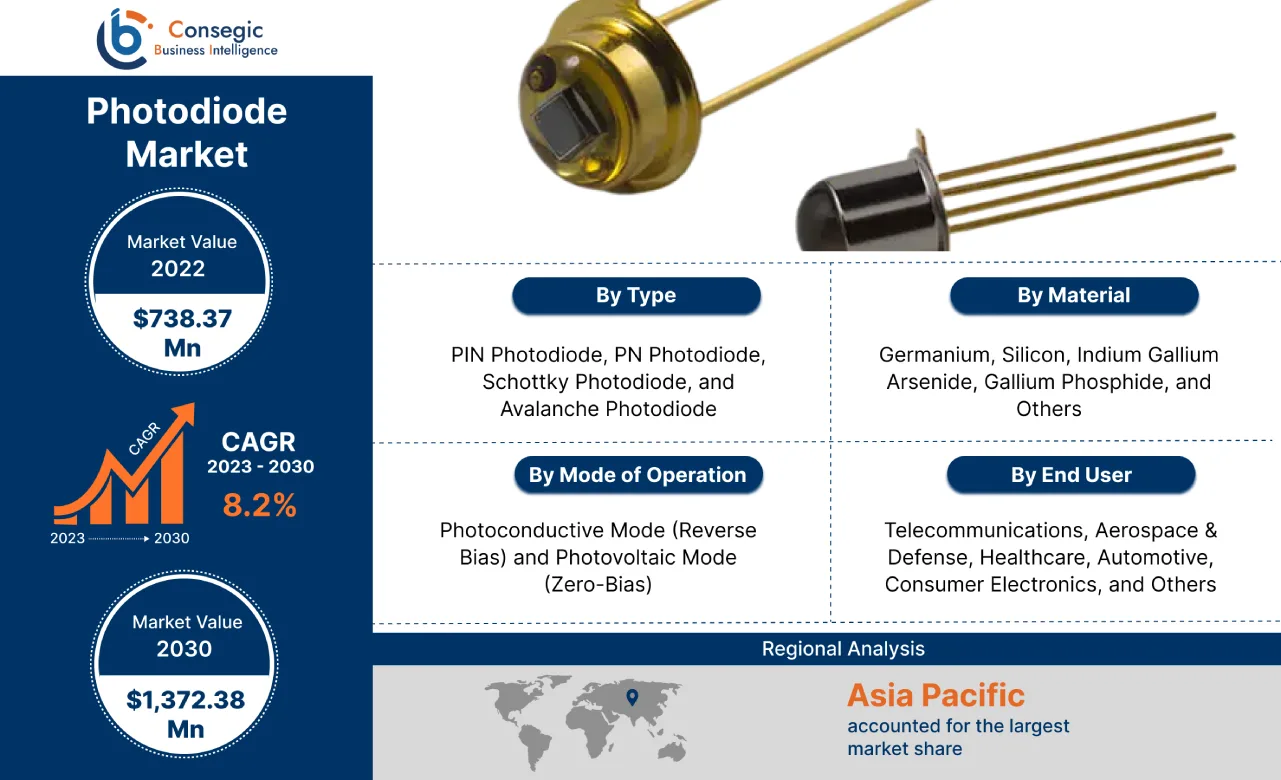Photodiode Market Size :
Photodiode Market is estimated to reach over USD 1,372.38 Million by 2030 from a value of USD 738.37 Million in 2022, growing at a CAGR of 8.2% from 2023 to 2030.
Photodiode Market Scope & Overview:
A photodiode is a semiconductor device that converts light energy into an electrical current. They are sensitive to light across a specific range of wavelengths, depending on the construction and material. When light strikes the photodiode, photons from the light are absorbed by the semiconductor material, generating electron-hole pairs. The electron-hole pairs create an electric current proportional to the intensity of the incident light. Additionally, they are employed in various applications including optical communication systems, light detection and ranging (LiDAR), barcode readers, and optical sensors, among others to accurately measure the intensity of light.
Photodiode Market Insights :
Photodiode Market Dynamics - (DRO) :
Key Drivers :
Growing adoption of smartphones raises the demand for photodiodes for ambient light sensing and gesture recognition.
Smartphones utilize photodiodes as ambient light sensors, to measure the surrounding light conditions, enabling the device to automatically adjust the display brightness for optimal visibility and conserve battery life. The increasing demand for smartphones with enhanced display capabilities is driving the need for more accurate and sensitive ambient light sensors thereby boosting the market. Additionally, smartphones employ gesture recognition technology, enabling users to interact with the devices through gestures including waving or swiping. Photodiodes are utilized in gesture recognition modules to detect the reflected light from the user's hand movements. The integration of gesture recognition capabilities in smartphones is contributing significantly to accelerating the market. Consequently, market analysis shows that the growing adoption of smartphones is increasing the demand for photodiodes to provide ambient light sensing and gesture recognition, which in turn, is promoting the market.
- For instance, according to the India Cellular and Electronics Association (ICEA), smartphone shipments accounted for 225.4 million units in 2020 as compared to 206.5 million units in 2019, with a rise of 9.2%. In addition, smartphone shipment is projected to reach 351.6 million by 2024, thus contributing remarkably to propelling the photodiode market growth.
Rising adoption of Advanced Driver-Assistance Systems (ADAS) in the automotive industry is propelling the market.
The automotive industry is witnessing a rapid adoption of ADAS that includes technologies namely adaptive cruise control, lane departure warning, collision avoidance, and automatic emergency braking. Photodiodes are installed in the systems for performing tasks including object detection, distance measurement, and ambient light sensing. Additionally, they are extensively employed in automotive lighting applications owing to their enhanced energy efficiency and longevity. They are utilized in LED lighting systems for light sensing and feedback control, ensuring consistent illumination and adjusting brightness levels based on ambient conditions, thus contributing notably to fueling the photodiode market growth.
- For instance, in December 2020, Vishay Intertechnology, Inc. launched a 4-quadrant silicon PIN photodiode with high photosensitivity for automotive applications. The photodiodes are designed to offer an improved signal-to-noise ratio and effectively function using epitaxial technology with a floor life of 168 hours.
Moreover, the high sensitivity offered by photodiodes enables small signal detection for automotive light sensors resulting in an excellent signal-to-noise ratio. Furthermore, analysis of market trends shows that the emergence of epitaxial technology enables them to function efficiently over a wide range of sensitivities to deliver exact results, hence contributing considerably to spurring the market.
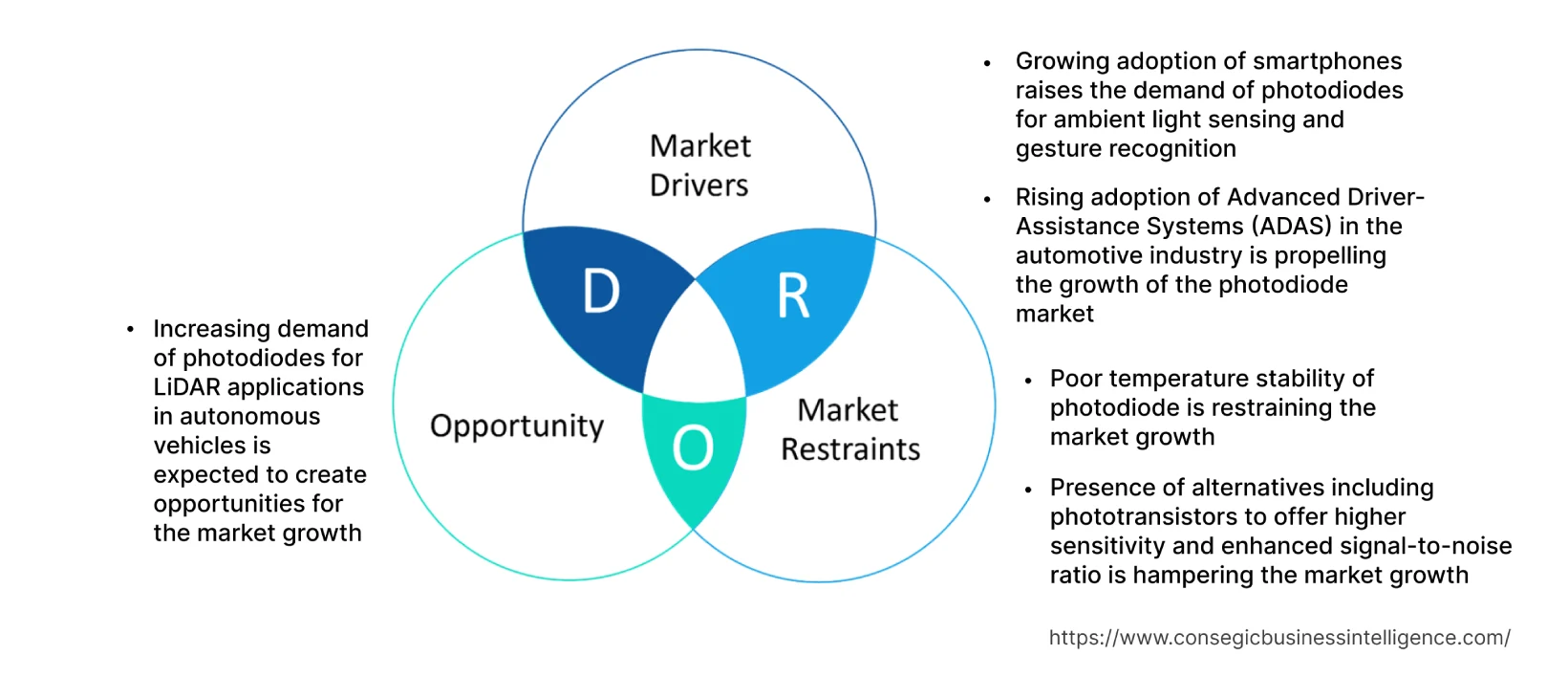
Key Restraints :
Poor temperature stability of photodiodes is restraining the market.
Poor temperature stability of photodiodes results in degraded performance, affecting the ability to accurately convert light into electrical signals. The inefficient conversion leads to measurement errors, reduced sensitivity, and decreased signal-to-noise ratio, negatively impacting the performance. Additionally, temperature instability impacts the long-term reliability and operational lifespan. Extreme temperature variations cause thermal stress, resulting in accelerated aging, increased failure rates, and reduced system reliability. Moreover, temperature fluctuations introduce measurement inaccuracies in photodiode-based systems, leading to incorrect light measurement and sensing, hence impeding the photodiode market demand.
Presence of alternatives including phototransistors to offer higher sensitivity and enhanced signal-to-noise ratio is hampering the market.
Phototransistors exhibit higher sensitivity to light as compared to photodiodes, hampering the market. The higher sensitivity allows for the detection of lower light levels, suitable for applications with weak or distant light signals. Additionally, the presence of a built-in amplification stage in phototransistors improves the signal-to-noise ratio (SNR). Phototransistors amplify the weak light signal and provide a stronger output signal relative to the noise, resulting in improved detection accuracy and performance. Moreover, phototransistors have faster response times, further hindering the market. The transistor component allows for faster switching and amplification of the light signal, enabling quicker detection and response to changes in light intensity. Consequently, analysis of market trends depicts that the aforementioned factors including improved sensitivity, enhanced signal-to-noise ratio, and faster response time offered by phototransistors are restraining the photodiode market demand.
Future Opportunities :
Increasing demand for photodiodes for LiDAR applications in autonomous vehicles is expected to create opportunities.
LiDAR (Light Detection and Ranging) technology plays a crucial role in autonomous vehicles by providing 3D perception and mapping of the surrounding environment. Photodiodes are essential components in LiDAR systems, to detect and measure the reflected light create detailed maps, and detect obstacles. In addition, they are utilized in autonomous vehicles for object detection and collision avoidance systems. The systems rely on sensors, including photodiodes, to detect and analyze the environment in real time, enabling the vehicle to detect other vehicles, pedestrians, and obstacles. Subsequently, the market trends analysis shows that the increasing number of autonomous vehicles is expected to drive the photodiode market opportunities for LiDAR applications, object detection, and collision avoidance systems.
Photodiode Market Report Insights :
| Report Attributes | Report Details |
| Study Timeline | 2017-2030 |
| Market Size in 2030 | USD 1,372.38 Million |
| CAGR (2023-2030) | 8.2% |
| By Type | PIN Photodiode, PN Photodiode, Schottky Photodiode, and Avalanche Photodiode |
| By Material | Germanium, Silicon, Indium Gallium Arsenide, Gallium Phosphide, and Others |
| By Mode of Operation | Photoconductive Mode (Reverse Bias) and Photovoltaic Mode (Zero-Bias) |
| By End-User | Telecommunications, Aerospace & Defense, Healthcare, Automotive, Consumer Electronics, and Others |
| By Region | North America, Europe, Asia-Pacific, Latin America, and Middle East & Africa |
| Key Players | Edmund Optics, Excelitas Technologies Corp, First-sensor AG, Hamamatsu Photonics Deutschland, Panasonic Corporation, Kyosemi Corporation, OSI optoelectronics, OSRAM Optoelectronics, Rohm Semiconductor, Semtech Corporation |
Photodiode Market Segmental Analysis :
By Type :
The type segment is classified into PIN photodiode, PN photodiode, Schottky photodiode, and avalanche photodiode.
PIN photodiode accounted for the largest market share of 37.4% in 2022 and is also projected to witness the fastest CAGR in the upcoming years. The rise is attributed to the ability of the PIN photodiode to exhibit high sensitivity to light to detect low levels of light accuracy. Additionally, they detect a broad range of wavelengths, including visible, near-infrared, and ultraviolet light. The versatility offered by these diodes is applicable in diverse fields including telecommunication, industrial sensing, medical devices, and scientific research. Moreover, they have a faster response time to detect rapid changes in light intensity and are relatively more cost-effective in comparison to other diodes, further contributing to photodiode market trends.
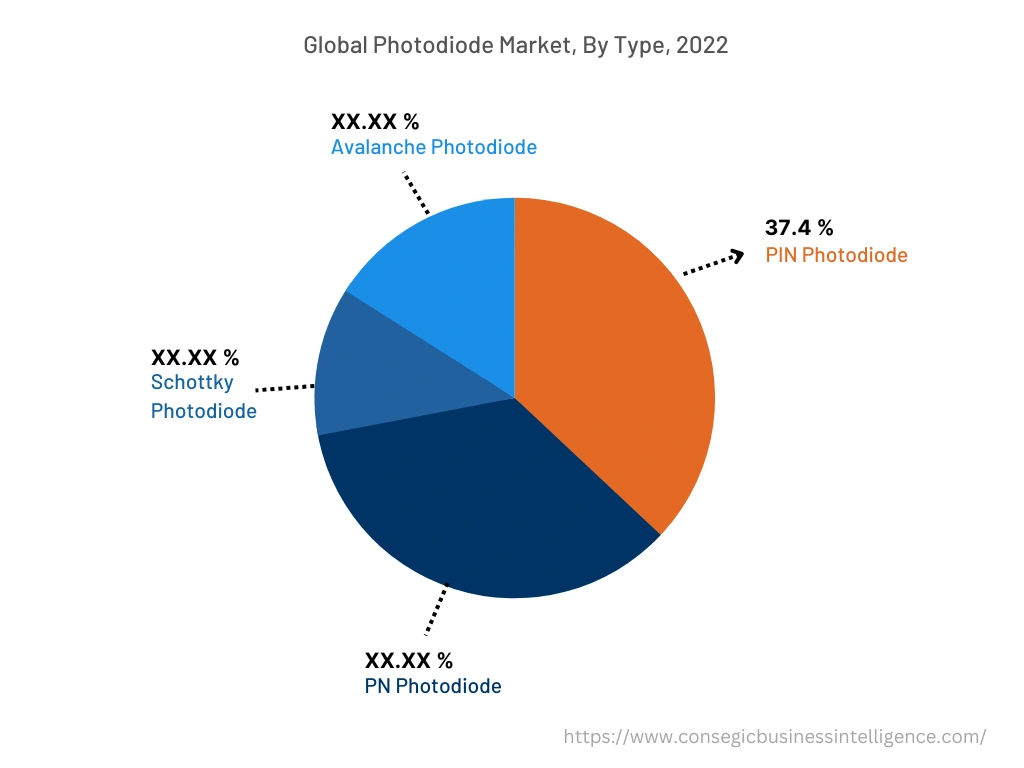
By Material :
The material segment is classified into germanium, silicon, indium gallium arsenide, gallium phosphide, and others.
Silicon accounted for the largest market of the overall photodiode market share in 2022 as silicon has a moderate bandgap, allowing for efficient absorbance of visible light and a portion of the near-infrared spectrum. The moderate bandwidth allows silicon photodiodes to be utilized for a wide range of applications including consumer electronics, industrial automation, and optical communications. Additionally, they are easily integrated with Complementary Metal-Oxide-Semiconductor (CMOS) technology, which is extensively employed in the semiconductor industry. The integration allows for the development of cohesive photodiode arrays and also enables the co-integration of photodiodes with other electronic components, enhancing functionality and reducing costs. In conclusion, the segmental trends analysis shows that the aforementioned factors including the presence of moderate bandwidth and the integration of complementary metal-oxide-semiconductor (CMOS) technology are contributing collectively to driving the photodiode market trends.
Indium Gallium Arsenide (InGaAs) photodiodes are predicted to register the fastest CAGR in the upcoming years. The rise is credited to the ability of InGaAs photodiodes to offer excellent sensitivity in the near-infrared (NIR) spectrum, ranging from 500 to 2500 nanometers (nm). The wavelength range is particularly important in applications namely telecommunications, spectroscopy, and sensing, for the detection of light in the NIR region. Additionally, they exhibit high responsivity and quantum efficiency in the NIR range, to convert light into electrical signals with high sensitivity.
- For instance, in December 2022, Marktech Optoelectronics, Inc. launched two Indium Gallium Arsenide (InGaAs) photodiodes with wavelength ranges from 600nm to 2600nm. It is covered with a TO-18 hermetic metal to provide the highest protection against the ingress of vapor and moisture.
By Mode of Operation :
The mode of operation segment is categorized into a photoconductive mode (reverse bias) and photovoltaic mode (zero bias).
Photovoltaic mode accounted for the largest market share of the total photodiode market share in 2022 as photovoltaic mode photodiodes generate current directly proportional to the incident light intensity eliminating the need for an external bias voltage. Additionally, photovoltaic mode photodiodes also exhibit a linear response over a wide range of light intensities. Linearity is advantageous in applications that require accurate and reliable measurements including optical sensing and imaging. The linear response allows for precise quantification and interpretation of light signals, thus contributing significantly to driving the growth of the photovoltaic mode of operation.
The photoconductive mode is anticipated to register the fastest CAGR in the market during the forecast period. The rise of the market is attributed to the ability of photoconductive mode photodiodes to offer higher sensitivity as compared to photovoltaic mode photodiodes. In photoconductive mode, the reverse bias applied to the photodiode allows for amplification of the photocurrent, resulting in increased sensitivity. The reverse bias enables photodiodes to be used in applications that require low-light detection or weak signal measurements, namely scientific research, photon counting, and low-light imaging. Additionally, it exhibits faster response times as compared to photovoltaic photodiodes, suitable for high-speed detection including optical communications, data transmission, and high-frequency sensing. Its fast response times enable rapid signal detection and processing, hence contributing remarkably to accelerating the photodiode market trends during the forecast period.
By End-User :
The end-user segment is categorized into telecommunications, aerospace & defense, healthcare, automotive, consumer electronics, and others.
Telecommunication accounted for the largest market share in 2022 as photodiodes are extensively employed in optical communication systems to convert optical signals into electrical signals and vice versa. Additionally, the emergence of 5G technology to provide faster data speeds and higher network capacity is also contributing to the market growth. They play a critical role in receiving and converting the high-speed optical signals used in 5G networks and for transmitting data between the cell towers and the central network infrastructure. Moreover, the government is also investing heavily to improve the telecommunication infrastructure, further accelerating the market growth.
- For instance, in April 2023, the United Kingdom government invested approximately USD 51.18 Million to boost the 5G infrastructure of the country. The investment aims to provide standalone 5G to all populated areas by 2030, thus contributing considerably to accelerating the growth of the photodiode market.
Consumer electronics is expected to witness the fastest CAGR in the market during the forecast period. The growth of the market is credited to the increasing adoption of photodiodes in consumer electronic devices for ambient light sensing. They measure the surrounding light intensity and enable automatic adjustments to the device's display brightness or keyboard backlighting. The feature ensures optimal visibility and energy efficiency, enhancing user comfort and extending battery life. Additionally, they are used in combination with infrared (IR) LEDs to enable proximity sensing in consumer electronics. They determine the presence or absence of nearby objects including screen dimming during phone calls or gesture-based controls by emitting IR light and detecting the reflected light. In conclusion, the segmental trends analysis shows that the aforementioned factors are collectively responsible for driving the growth in the consumer electronics industry during the forecast period.
By Region :
The regional segment includes North America, Europe, Asia Pacific, the Middle East and Africa, and Latin America.
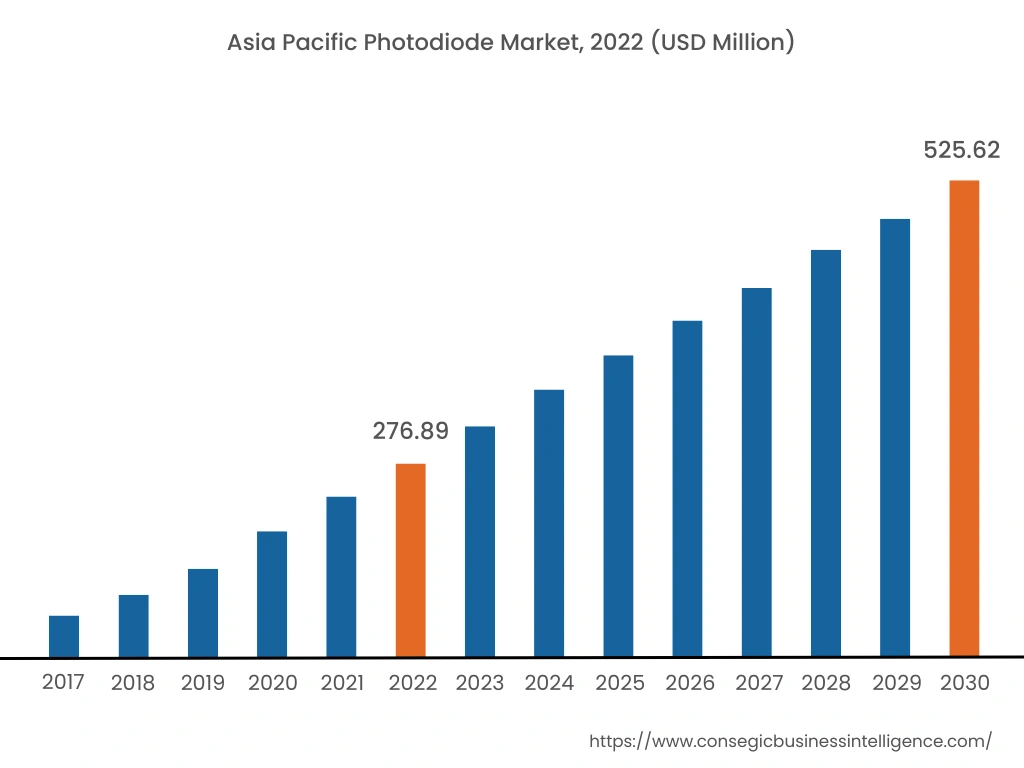
Asia Pacific accounted for the largest market share in 2022 valued at USD 276.89 Million and is predicted to register the fastest CAGR of 8.5% accounting to USD 525.62 Million in 2030 in the photodiode market. In addition, in the region, China accounted for the maximum revenue share of 33.40% in the year 2022. As per the photodiode market analysis, Asia Pacific is a major manufacturing hub for electronic components, including photodiodes. The region encompasses several countries with well-developed electronics manufacturing industries including China, Japan, South Korea, Taiwan, and Singapore. The expanding electronics manufacturing industry increases the demand for photodiodes for ambient light sensing in consumer electronic devices such as smartphones, tablets, and televisions. Consequently, the expansion in the electronics manufacturing industry is contributing notably to promoting the photodiode market expansion in the Asia Pacific. For instance, according to the India Cellular and Electronics Association (ICEA), the electronic manufacturing industry in India grew from USD 37.1 billion in 2015-16 to USD 67.3 billion in 2020-21.
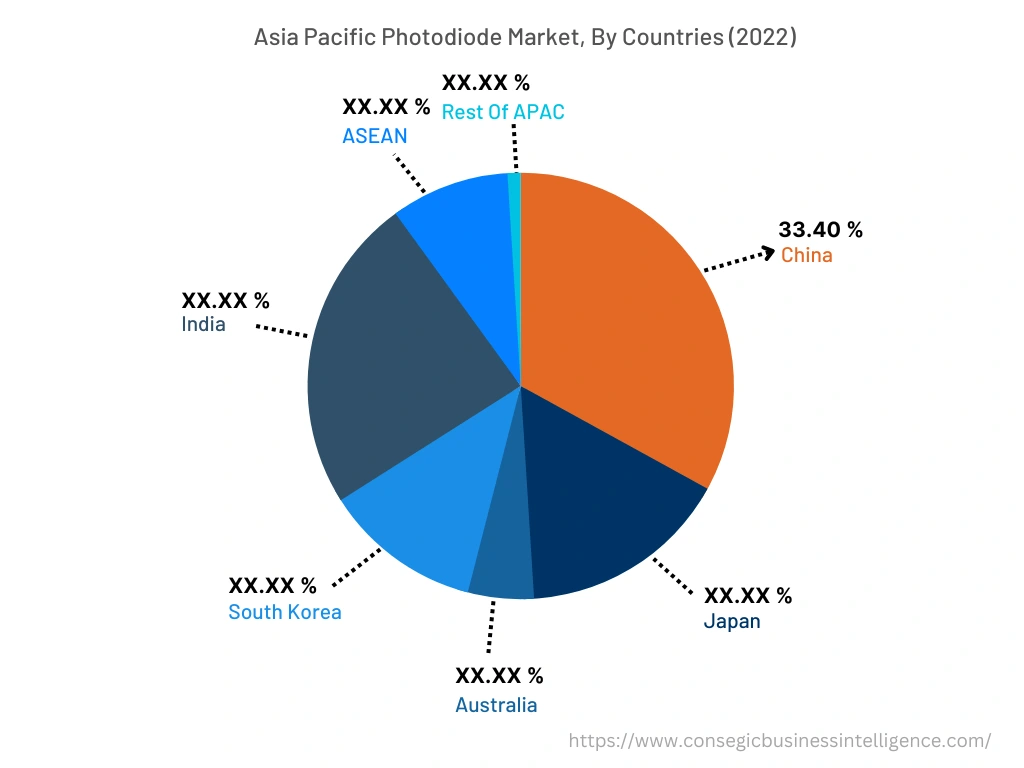
Top Key Players & Market Share Insights:
The landscape of the global photodiode market is highly competitive. The key players in the market are adopting strategies for acquisitions mergers, and product innovations to stay competitive in the market. Following are the major market players that comprise the latest photodiode industry concentration: –
- Edmund Optics
- Excelitas Technologies Corp
- OSRAM Optoelectronics
- Rohm Semiconductor
- Semtech Corporation
- First-sensor AG
- Hamamatsu Photonics Deutschland
- Panasonic Corporation
- Kyosemi Corporation
- OSI optoelectronics
Recent Industry Developments :
- In March 2021, IMB-CNM celebrated the fifth launch of 36 of the OneWeb satellites, equipped with photodiodes and constructed in the Clean Room of the Barcelona Institute of Microelectronics. The satellites are composed of solar tracking sensors that comprise silicon photodiodes to serve as solar tracking sensors for the satellites.
- In February 2020, Panasonic Corporation introduced a time-of-flight image sensor with an advanced avalanche photodiode of one million pixels to offer high resolution and sensitivity to the TOF image sensor.
Key Questions Answered in the Report
What is Photodiode? +
A photodiode is a semiconductor device that converts light energy into an electrical current.
What specific segmentation details are covered in the photodiode market report, and how is the dominating segment impacting the market growth? +
Telecommunication dominates the market as photodiodes are extensively employed in optical communication systems to convert optical signals into electrical signals and vice versa. Additionally, the emergence of 5G technology to provide faster data speeds and higher network capacity is also contributing to the market growth.
What specific segmentation details are covered in the photodiode market report, and how is the fastest segment anticipated to impact the market growth? +
The InGaAs photodiodes are expected to witness the fastest CAGR as InGaAs photodiodes exhibit high responsivity and quantum efficiency in the NIR range, to convert light into electrical signals with high sensitivity.
Based on current market trends and future predictions, which geographical region will have the largest impact on the photodiode market's growth in the coming years? +
Asia Pacific is anticipated to register the largest impact on the photodiode market owing to the expanding electronics manufacturing industry.
